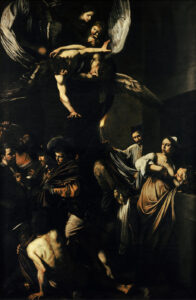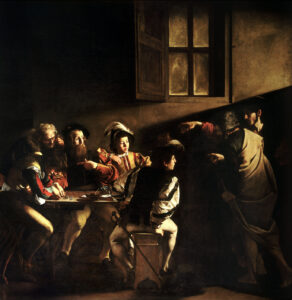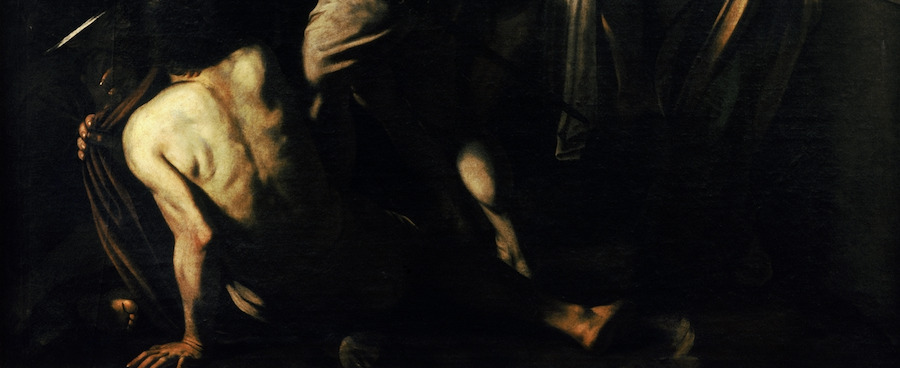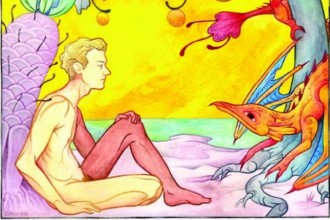‘…when you give to the needy, do not announce it with trumpets, as the hypocrites do in the synagogues and on the streets, to be honoured by others. Truly I tell you, they have received their reward in full. But when you give to the needy, do not let your left hand know what your right hand is doing, so that your giving may be in secret. Then your Father, who sees what is done in secret, will reward you.’
Matthew 6:2-4
The very fact that one may speak of a ‘history of art’ is itself a testament to a kind of persistent poverty: the ubiquitous need for humans to express what is hidden or not immediately apparent. Yes, the history of art is a continuous commentary on poverty—visible and intrinsic—and endless are the examples from which to choose. Confounded by such a wealth of human creativity, there is, however, one work which offers a profound theological statement and insight into the impoverished condition of mankind, played out in the ambiguities which plague every human action. Le Sette Opere della Misericordia (c.1607) was painted in a kind of self-imposed exile, indeed, apparently the first one Caravaggio painted after having killed a man, mercilessly, in an untempered rush of anger and agitation. It was during this delicate time—a criminal hunted by the Law—that incredibly, Caravaggio received a commission from the Confraternity of the Pio Monte della Misericordia for an altarpiece of its church: the Seven Acts of Mercy.[1]
 The Confraternity that commissioned the altarpiece was a relatively new one in Naples. Founded in 1602 by seven noble Neapolitans, it was dedicated to the practice of the seven acts of corporeal mercy, particularly in tending to the sick, stressing the belief that charitable acts could prepare humanity for salvation. Taken in the context of Jesus’ teaching on justice and divine judgement,[2] the corporeal works of mercy may be understood as a channel of grace and salvation. Already in the portals of medieval churches,[3] we find representations of the works of mercy alongside depictions of the Last Judgement and other related narratives, such as that of the parable of the wise and foolish virgins,[4] taken from the same chapter of Matthew’s Gospel with which the acts of mercy are most often associated (Mt 25). In other words, to enter through the door—which is Christ—into the heavenly Jerusalem, one must bring the oil of his or her lamp: the labour and essence of one’s life; mankind’s mandate to partake in the narrative of creation.[5]
The Confraternity that commissioned the altarpiece was a relatively new one in Naples. Founded in 1602 by seven noble Neapolitans, it was dedicated to the practice of the seven acts of corporeal mercy, particularly in tending to the sick, stressing the belief that charitable acts could prepare humanity for salvation. Taken in the context of Jesus’ teaching on justice and divine judgement,[2] the corporeal works of mercy may be understood as a channel of grace and salvation. Already in the portals of medieval churches,[3] we find representations of the works of mercy alongside depictions of the Last Judgement and other related narratives, such as that of the parable of the wise and foolish virgins,[4] taken from the same chapter of Matthew’s Gospel with which the acts of mercy are most often associated (Mt 25). In other words, to enter through the door—which is Christ—into the heavenly Jerusalem, one must bring the oil of his or her lamp: the labour and essence of one’s life; mankind’s mandate to partake in the narrative of creation.[5]
The portico of the church of Pio Monte della Misericordia does not boast such decoration. However, its function nonetheless carries a similar meaning: to receive and offer shelter to the one who is ‘outside’—the pilgrim, the stranger, the criminal, but also the one outside the church who approaches and waits at the gate of divine mercy. Furthermore, the chapel itself was only later increased in size.[6] Initially, the altar (and the Caravaggio altarpiece) would have appeared closer to the door, as if the painting itself was the door through which one must pass: the door of the seven acts of mercy.
In the narrow, densely congested space of the door-canvas, Caravaggio groups together several personalities performing one—or, in most cases, two—acts of corporeal mercy.[7] Although there is much to say about each one, I will, however, only focus on the group in the foreground as this directly concerns the mission of the Confraternity and, perhaps more pertinent to our topic, it reveals the hidden dimension of poverty.
Here, a nearly naked man receives a piece of red fabric cut from the cloak of a man who stands before him.[8] The naked figure, however, is anonymous; he is without a face. To be without clothes is not simply a material poverty, but above all a spiritual poverty, a spiritual nakedness; it is to be without dignity, without identity. In a sense, then, to clothe is to re-invest one with dignity, allowing one to stand on his or her feet. As some commentators remark,[9] this figure resembles the way lepers are often portrayed: paralysed and unable to walk.[10] At the lower left-hand side is another foot, alongside that of the naked man, lit-up as well, but belonging to a person who is completely shrouded in the dark: in the deepest and most absolute darkness, hidden from sight, is a beggar. With clutched hands, he pleads for alms or, at least, for attention in absolute darkness, pierced only by the glint of St Martin’s sword, who, in fact, seemingly looks in the direction of this hardly visible figure: a cripple, ill-looking presence in the shadows.
Although the lower half of the painting lacks a clear point of focus, the act of visiting and tending to the sick is almost completely set in the dark, hidden from view, with an intentionality that points back to the Gospel of Matthew (Chap. 6 and 25). Here lies perhaps one of the main interpretative keys to understand the obscurity of this part of the painting: that although those who hold a torch on their good actions might be more visible, those who are hidden from our view are just as worthy of our attention, if not in fact the most. The greatest act of charity is perhaps towards those who are truly hidden. The truly poor are not those who cry out in their poverty, but those that hide away, ‘the least of these’ of whom Christ speaks.[11]
As it were, neither the blessed nor the condemned could see Christ ‘in the least of these’.[12] Thus, the revealing light descends on the scene through a source other than the torch; it is a light which reveals the extent of mankind’s need for salvation, its dependency on an intercessor and inability to save itself. The painting, too, suggests that those performing good acts are themselves seemingly in need of as much mercy and charity; nor can their actions be unreservedly interpreted as ‘good’.[13] There seems to be in all this an invitation to consider the intent and, hence, origin of every action. Even the ear, behind the figure of St Martin, thus gains more prominence: the inability to see what is hidden is one thing, but the inability to discern the intent of our actions is, perhaps, an even greater and disturbing echo of the original act of impoverishment, which in the Judeo-Christian tradition could be traced all the way back to the Genesis.
All this ambiguity, including that embodied by the angels caught somewhere between a struggle and an embrace, is countered by what is perhaps the only untainted and straightforward example of self-gift: the figure of a woman holding a child. Clearly adopting the iconography of the Madonna Mediatrix typology, Caravaggio depicts the Virgin and Child in the intermediary space between heaven and earth, thus assuming the role of intercessor,[14] but combines this also with the iconography of the Madonna del Soccorso who is typically portrayed offering her mantle or veil to the people, as if it were a tent or shelter. In Caravaggio’s rendition, this veil is present too—white which gradually turns black—descending into the darkness below and once again seemingly turns up as the red mantle thrown over the shoulder of St Martin of Tours who offers it to the naked man. It is as if grace (white) descends into the obscurity below (black), becoming incarnate (red) and finally offered to mankind; the process of incarnation.
And the Incarnation might be the entire point; the ultimate act of charity and self-gift: God descending into the poverty and despair of mankind, becoming the poor, sickly child we see in the painting, and of whom we read in the Gospels: the “criminal” who took on the sins and evils of mankind to cleanse us of those same sins and evils, to restore humanity to God, restoring it with dignity. This may thus serve as a reminder of one’s poverty, of one’s afflicted and sinful condition since the beginning. To sin, to distance oneself from the source of unconditional love, is to be poor.
Perhaps this tension between acts of charity, of self-gift and penance, primarily stemmed from Caravaggio’s own personal and conflicted condition; equally wanted for his art and for his crimes, for his creative and destructive work, so to speak.But not only. Caravaggio, as all artists do or try to do, sees things differently: he could see in the poverty of daily life, as perhaps in his own life, the workings of God. The upper part of the painting (the Virgin and Child, the angels) is apparently not visible to the people below. Yet, to the beholders of this painting, that is us, all is visible. Who sees this painting, which is after all an altarpiece, sees also the sacrifice that happens on the altar with every Mass: the celebration of the Eucharist, that is, the ultimate act of mercy. It is on this altar, where something so “poor” as a piece of unleavened bread becomes the body of Christ, that the infant Child Jesus born into extreme poverty and simplicity is the Christ Jesus who completely offers himself up in an act of self-gift.
Thus, the one who is able to perceive the greatness of God, the greatness of self-gift in the ‘poverty’ of the Eucharistic meal of bread and wine, can thus also see, once the Mass has ended, the greatness of God’s grace and mercy in daily life, on the streets of Naples and the impoverished people who inhabit them. Caravaggio’s technique, the painting’s realismo, lends itself well to this: to the view of the work as an extension of the bustling street of Naples. Or as one commentator remarks: ‘With its teeming composition set in a nocturnal streetscape, the altarpiece may make you feel as if the cyclonic street life of the city has somehow followed you inside the church’.[15] It is for this reason, too, perhaps, that the Confraternity which commissioned it stipulated its ‘perpetual immovability’ where ‘the architecture, the context, is complementary to and inseparable from the extraordinary pictorial work’.[16]
Thus, the gaze of Caravaggio brings us—the viewers—to see differently, transforming our gaze into one in which we become aware of what the characters in the painting do not themselves seem to be aware of. It invites us to see what is hidden, inviting us to adopt the gaze of God, ultimately lifting our gaze towards the higher act of mercy: God’s incarnation and descent into the world, into the troubles and suffering of the people, our neighbours. As Pacelli argues: ‘It is not with Caravaggio a question of verisimilitude, of mere imitation, things seen, but dogged and aimed at encompassing all aspects (here reaching sublime heights) to visualize the world in quite a new way’.[17] And this ‘new way’ points to an even greater realism and naturalism than the painting itself (which, in its totality is rather quite unrealistic).[18] And it points, furthermore, to ‘a deeper and richer kind of truthfulness’ which cannot be attained by focussing on the specific details of the painting. To see anew is, after all, a kind of conversion.[19]
We must therefore step away and put some distance between us and the painting. We must, in fact, stand at the door of the church, between the earthly streets of daily life and the heavenly realm, the promise of the celestial Jerusalem, of the merciful Father and salvation. There, at the door, the pivot of mercy and site of revelation, is the Christ who tells his disciples and those who accuse and question God, the ‘Father of compassion’[20]: Go and learn what this means: ‘I desire mercy, not sacrifice.’ This missio, which is a response to the Pharisees who accuse Christ of dining with tax collectors, follows the scene in which Christ calls Levi (Matthew) to leave the table of exploitation and selfishness and towards that which engenders and sustains life.[21] Matthew’s call, then, also tells us something about the intrinsic relation between mercy, poverty, and creation. And there is perhaps no other detail that so aptly captures this than the hand of Christ as depicted in another of Caravaggio’s masterpieces: The Call of St Matthew.[22] This is not just any hand but the hand of Adam, lifted from Michelangelo’s rendition of The Creation of Adam. Here, however, the hand of Adam is in the position of God’s. For it belongs to the ‘new Adam’, the Son of God incarnate, who calls and re-creates those he calls, bestowing them with their new name.
The distance between the hand of Christ and Matthew, between the sheep and the goats, the cloth and the naked man, the merciful and the miserable, the painter’s brush and the bare canvas, is an act of creation which flows from the same source of blessing that creates and makes things ‘good’. The creative gesture is the place of mercy which acts against what is impoverished, without face, without identity, hope, dignity; it is the expression of a ‘moved heart’ (misere-cordium) before the afflictions of others, resulting in things made new and thus part of the great narrative of creation, and particularly of mankind’s redemption and rediscovery that every person is an image, a ‘good image’ made in the image and likeness of a Creator.
And this ‘good image’ to which we all may aspire becomes all the more evident when a mirror, or an altarpiece, showing the impoverished condition of mankind is held up to us, and we see ourselves among the protagonists—the merciful and the miserable—called to act mercifully without intent of reward, and especially with those who are most difficult to see, while even then recognising that we are ourselves in need of just as much mercy, afflicted as we are by a poverty that is perhaps not as immediately visible.
[1] The Confraternity of the Pio Monte della Misericordia met on Fridays at the Hospital for the Incurables. It might be worth pointing out that this is also to be seen in the context of Counter-Reformatory Europe: to be actively participant in faith, to express faith through works is necessary; it matters for it involves a progression towards what is good, beautiful and true: an “active waiting” of salvation where solo fides non basta, an anti-Protestant polemic. Cf. Maria Cristina Terzaghi, ed., Caravaggio Napoli (Electa, 2019), 30-59.
[2] Mt 25:31-46.
[3] For example, Antelami’s reliefs on the jambs of the west facade of the Parma Baptistry (1196) and, later, the carvings found on the Galluspforte at the Basel Munster.
[4] Mt 25:1-13.
[5] Notably, on the World Day of Prayer for Creation in 2016, Pope Francis referred to the ‘care for creation’ as a new work of mercy, which complements and extends on the existing “traditional” works of mercy.
[6] See Loredana Gazzara, ‘Caravaggio nella prima cappella del Pio Monte della Misericordia’, in Caravaggio Napoli, eds. Maria Cristina Terzaghi and Sylvain Bellenger (Electa, 2019), 63.
[7] Refer to the images and annotations for the identification of each act of mercy.
[8] This man can possibly be identified as the saintly figure of Martin of Tours.
[9] Gianluca Forgione, ‘L’avete fatto a me’, Per una nuova lettura delle Sette opere di Misericordi di Caravaggio’, Studi di Memofonte, no. 23 (2019): 123.
[10] Coincidentally, to be unable to walk, to be a cripple, is the etymologically linked to sin itself: peccatum, or in its explanded form: pes captum (‘captive foot’), and therefore, the inability to walk. The convergence between sin (in particular that of original sin) and poverty is slightly elaborated further on in this article. However, for an even more extensive discussion on the topic refer to Prof. Nadia Delicata’s talk from the same series of lectures on Mercy and Caravaggio’s Sette Opere della Misericordia, organised by the Centre of Ignatian Spirituality, Malta: https://www.youtube.com/watch?v=PqdkSCau0RM.
[11] Mt 25:40.
[12] This was, in fact, the case in the infamous anecdote of St Martin and the beggar at the city gates. For a discussion on how this may refer to the intent of an action and how, in turn, this is reflected in Caravaggio’s painting, see: https://www.youtube.com/watch?v=I-E4zsH0Duk&t=3100s.
[13] Note, for example, the defensive stance by which the pilgrim holds his staff or the ambiguity behind the intention of the innkeeper who, perhaps, points the pilgrims towards the nearest shelter thus relieving himself from the responsibility of hospitality. Better still, the gesture of St Martin might be interpreted as an attempt to withhold the garment from the clutches of the naked man.
[14] This expresses the deep theology behind the title of Mary as ‘our Lady of mercy, or Mother of divine mercy’, whereby—as explained in the Second Vatican Council—‘being assumed into heaven, she has not laid aside the office of salvation but by her manifold intercession she continues to obtain for us the graces of eternal salvation. By her maternal charity, she takes care of the brethren of her Son who still journey on earth surrounded by dangers and difficulties, until they are led into their blessed home.’ Dogmatic Constitution of the Church, Lumen gentium, No. 62, AAS 57 (1965), 63. Cf. Dives in Misericordia, V.9.
[15] Francine Prose, ‘On the trail of Caravaggio’, Smithsonian, 37 no. 12 (2007): 86.
[16] Signor Presidente, ‘Roma rinunci alla “Sette Opere” del Caravaggio, in Corriere del Mezzogiorno, 16 February 2016.
[17] Vincenzo Pacelli, ‘New Documents concerning Caravaggio in Naples’, The Burlington Magazine, Vol. 119 No. 897 (1977): 826.
[18] Cf. Luca Tateo, ‘Caravaggio’s The Seven Works of Mercy and the Art of Generalization’, in Subjectivity and Knowledge, eds. C. I. Højholt and E. Schraube (Springer, 2019), 146-156.
[19] In Pope St John Paul II’s words: ‘Conversion to God is always the fruit of the rediscovery of the Father, who is rich in mercy.’ John Paul II, Dives in Misericordia, VII.13.
[20] 2 Cor 1:3.
[21] Mt 9:11.
[22] Michelangelo Merisi da Caravaggio, The Calling of St Matthew, 1599, San Luigi dei Francesi, Rome (Creative Commons).




